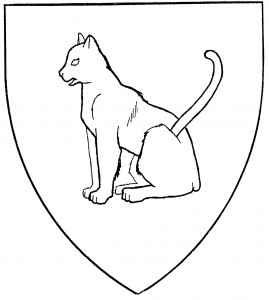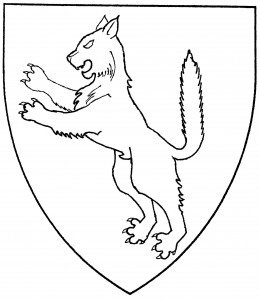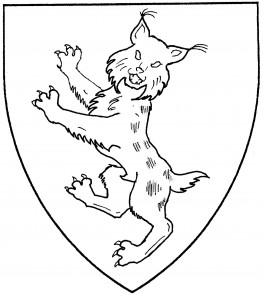The cat is a feline beast, famed for its deceitfulness. It’s a period charge, found in the arms of Vaughn, c.1520 [DBA1 201].
In mundane blazons, the simple term “cat” usually refers to the wild cat, most commonly associated with Scots heraldry; but in Society blazons, “cat” refers to the domesticated cat. The two forms should be distinguished in blazon to avoid confusion, the first as a “wildcat” or “cat-a-mountain” (Bossewell, 1572 [I.56], also terms it a “musion”), the latter as a “domestic cat” or “house cat”. No difference is granted between them.
The cat does not seem to have a default posture; the illustrations show a domestic cat sejant and a wildcat salient. Other postures, peculiar to the cat, include “herissony”, with arched back, raised fur, and spitting; de Bara, 1581 [168] shows a cat in this posture. The posture “s’élongeant”, stretching (as only a cat can), is currently disallowed, as blurring the distinction between passant and couchant. Finally, there’s the Society-unique “cat in its curiosity”, on its hind legs peering into a cauldron, which is about to tip over on it; it too is no longer permitted, as the motif has not been found in period armory.
Similar to the cat is the “lynx”, a spotted feline with tufted ears, prominent side whiskers, and a stub tail; its medieval reputation was for keen eyesight. Though sometimes considered synonymous with the wildcat, the two seem to have been separate beasts in period armory. The lynx was used in the canting arms (German Luchs) of Lüchsperger, mid-16th C. [NW 44], and as the crest and a supporter of the Worshipful Company of Skinners, 1550 [Bromley & Child 223]. The illustration shows a lynx rampant guardant.
For related charges, see lion, panther, tyger.
Gilles of Lennox bears: Or, a domestic cat sejant, paw extended sable.
Rianna Whirlwind bears: Azure, a wildcat statant guardant argent, a bordure argent semy of hawk’s bells vert.
Hvitr Loðinbak bears: Ermine, two lynxes rampant gardant addorsed gules.


